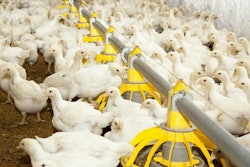
Mike Gauss, president of Kent Nutrition Group, explains how his company has adapted to the changing needs of today’s workers to attract and retain talent in today’s challenging economy.
PODCAST: Flexibility can help feed mills find, retain employees (11:56)
Ann Reus: Hello and welcome to the Feed Strategy podcast. I’m your host, Feed Strategy senior reporter Ann Reus.
I’m speaking today with Mike Gauss. He’s the president of Kent Nutrition Group in Muscatine, Iowa, and he’s here to talk about hiring and labor retention in the feed industry.
Hi Mike, thanks for being here.
Mike Gauss: Hi Ann, my pleasure.
Reus: How is the labor situation for you right now? Has it been difficult to find and retain the right people for the right jobs at your feed mills during the pandemic?
Gauss: It’s been a real challenge, Ann. I don’t think that we at Kent Nutrition Group are any different than other industries or other companies within our space. But it’s absolutely been a challenge. We’ve seen an uptick in retirement during this time of the pandemic. Additionally, we’ve just seen turnover, we’ve seen churn, especially with some of our newer employees that are churning, and also a blessing is that our volumes and our need and demand are up. So, our overall need for manpower is up as well. So, it kind of equates to a perfect storm of where we’re definitely having challenges to fill those positions, and to ensure that we have the needed people to be able to get all the products out to our customers. So it’s a challenging time for sure.
Reus: Now, those retiring employees, were they just at retirement age? Or did some of them take retirement earlier for specific reasons?
Gauss: Well, I think for the most part, we are lucky to have some really tenured employees, especially at some of our management and leadership positions, that have really been staying with us for a strong number of years. And during some of the pandemic times, just said, ‘Hey, now’s as good a time as any for me to step away from the business.’ So, it wasn’t that we offered any kind of early retirement packages, or that they were looking to necessarily go, it’s that they had been with us for a long time, and decided that now was the right time. And in light of all the things going on with the pandemic, that now was the right time for them to step away, which was disappointing to see them go. It’s not like we’ve had a mass exodus by any means via retirement, but typically, our retirement and our turnover is incredibly low. So even a small uptick for us seems like a significant increase in retirements.
Reus: What types of labor challenges or changes have you encountered since the start of the pandemic?
Gauss: Well, I don’t want to be too political, but obviously, some of the government policies pose challenges, just in reducing the overall labor market and labor workforce, which was a challenge. We were seeing and continue to see fewer applicants than we used to. Just the overall applicant pool has been difficult, and it’s been less than what we typically are seeing, which is somewhat from those government policies, but also just because an uptick in overall demand, I think, across all industries. So, in almost every location where we have a facility, we’re definitely not the only ones looking for strong talent. So that’s been a challenge for us.
I think, additionally, we’ve seen people, as some of our office operations have gone to more flexible work structure, and we’re seeing employees at our manufacturing locations looking for a little bit more flexible work structure. So we’re working with them to try to implement some changes that can accommodate some of that, but that has also posed some challenges there. I think to go in, along those same lines, you can call it the great resignation, call whatever you like, I think that there is there is a momentum within society right now of people feeling like it’s a good time or a kind of an in-vogue time for people be changing jobs. And what we found is that strong number, over 80% of the folks that we’ve had leave, have come back to us and said, ‘You know, the grass was not greener, where I was moving towards, and I really want to come back.’ So we’ve been thankful for that, but it’s definitely a tough momentum in society of people just thinking it’s the cool time that they should be looking for other things, because some of their friends or family members have done that as well. So, there’s a number of factors that are pushing against us, and we’re really working on trying to come up with unique and innovative ways to overcome those.
Reus: Do you think the workforce of today is different than it was a few years ago, and how so?
Gauss: I do. I think that the workforce, somewhat as I said, are looking for different things. I think you have people looking for flexibility and starting to demand flexibility there, which poses challenges when you have fixed plants in locations that you need people coming in, operating equipment and being on site to accommodate. We have the ability to offer a little more flexibility with some of our salaried employees and are doing some of that, but it’s more challenging there in our plant and our store locations. But I think we’re still seeing some really good people. We still have really quality employees, but the labor market is changing. And I think desires and requirements and what people are looking for are changing as well, which just causes us to have to change as well. It’s not necessarily good or bad. It’s just different. And it’s causing us to evolve and change and in some ways get better.
Reus: Can you give me any examples of how you meet those changing and differing expectations?
Gauss: I think we’ve opened up some of our flexibility around things, whether that be start times, whether that be availability, if a certain role can work from home, we have been more flexible. I wouldn’t say that we are leading the industry in work from home, we still view that there is significant benefit in our people being together and working closely together and think that that actually drives more synergies and folks working from home. But where it’s appropriate, we are trying to be more flexible. I would say that we are looking for ways that we can accommodate folks, especially at our stores and our manufacturing locations. For instance, we never had part-time operators. We’ve since moved into that where we have people coming in and saying, ‘Hey, we’re willing to work Tuesday, Wednesday, Thursday, does that work for you?’ And in some cases where we’re in need, we say, ‘Yeah, we’ll find a way to make that work.’ Now, it’s not optimum. It’s not ideal. It’s not what we’d like to see. But that’s somewhat where the labor workforce is, and how we’re having to make some adjustments and shift to be able to continue to fully operate our facilities.
Reus: Has your company put in place any efficiencies in recent years that result in the need for less labor?
Gauss: We have, and I can specifically address those. We have put in definitely some automation things via plant control systems, which reduce the overall need for labor. We’ve done quite a bit on the packaging side of things, whether through more automated packaging systems, or robotic palletizers, those types of things. We have also put in additional micro tables or dosing systems that reduce the need for overall manpower and labor. We’ve done some autonomous fork trucks or robotic fork trucks to reduce the need for some of our warehouse staffing. And so that has helped us to some degree. But in most cases, it really changes the need of operators and moves from process operators to more process optimizers, which then can, in fact, drive the need and the skill level needed to work with and utilize some of those technologies. So yes, it definitely does reduce some of the overall manpower needs, which is beneficial when we’re struggling to find the manpower. But it also raises the level of skill set that’s needed for many of those positions, which can then also drive some challenges in finding those more highly skilled employees.
Reus: Do you have any tips for managers in a position like yours about what you’ve found that works or doesn’t work for employee retention these days?
Gauss: Well, that’s the million-dollar question. I think it comes from, you know, we talk a lot internally about it’s great for us to have great policies and programs and ideas on how we go attract talent. But it’s even more important on how do we make sure we take care of our current employees. Because if we don’t have to refill a position, then we’re only looking at filling positions that are driven by growth. And those are good challenges to have. So we focus a lot on how do we provide a culture and environment where we take care of our current employees. I mean, it’s the simple golden rule of treat people as you want to be treated. And we work really hard to have a strong culture where we can treat people as well as possible. It really does still matter, culture matters. Taking care of people matters, treating people well matters. And I think that that is a great place to start to make sure people feel appreciated and needed. And that’s a great place to start.
Additionally, it’s really talking, I think, with those individual employees and finding out what their needs are. Sometimes those don’t fit with the overall corporate goals, but if they do, it’s how do you remain flexible to where you can still accomplish your business needs and goals. But you can also work with those employees. And we try really hard to not be a one-size-fits-all approach. We try to have flexibility where we can within our different locations, because there may be some unique needs there that aren’t needs or desires in another location. So how do we try to be flexible within those spaces, to once again drive a culture of appreciating and accommodating those employees. But then it’s also really trying to think outside the box on how you’re recruiting and bringing people in. We’re doing a lot of things that we never used to do. We just had a job fair at one of our locations. We’ve not typically had to go quite that far on how we’re attracting talent, but we are.
I think another thing during this timeframe is really helping people to see the true overall compensation and benefits package that we provide for them. I think right now during the Great Resignation timeframe, and as I was mentioning earlier, people thinking that it’s kind of the cool or the fun time to look at new jobs. There’s a significant look at just what the hourly pay rate or the salary pay rate. And oftentimes, we find that some of our employees are neglecting to take a look at the total compensation. So we work hard to make sure that they’re fully aware of what profit sharing and benefits and all of those things roll up as a total compensation package or a total value to that employee. And it’s important to remind them of those. But it’s also important to continue to stick with employees, even if they would choose to leave. As I said, we found a number of employees that have stepped away that are returning and wanting to come back, which really, I think, speaks to our culture, it speaks to how we treat people, and we’re proud of those things. But there’s a whole lot of things, and I think another thing I would say is just keep trying stuff. I talked to a lot of other industry leaders. And sometimes we get caught up in having the best plans. Sometimes you’ve just got to throw ideas at the wall and see what works well in one area and what doesn’t. But I would really say it stems from that foundation of treating people well, it stems from that foundation of having a strong culture that we feel really proud of at Kent, and encouraging and making a situation where people want to stick around and they want to invite their friends and others to come work with them for Kent Nutrition Group. But it’s a super tough question, and it’s not like we have the market cornered on how to do it by any means.
Reus: Well, that all sounds like good advice and good information for others in the same position. Well, thanks, Mike, for speaking with me today. And thanks to the audience for listening. I’m Ann Reus for Feed Strategy.













